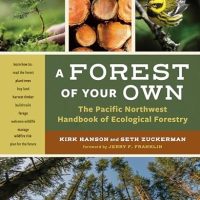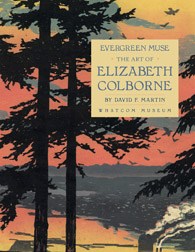
I grew up on five acres outside of Redmond, Washington of which about 75% was wooded. At the time, I had little understanding of the environmental complexity of this stand of second growth trees and other plants. I wish that A Forest of Your Own by Kirk Hanson and Seth Zuckerman had been available then. This new book explores private ownership of woodlands with a focus on ecological forestry, a term to describe management that considers all aspects and attributes of a wooded area. This is in contrast to a tree farm, or evaluating undeveloped land only as a source of timber. An ecological forest can provide timber, but much more, too. It conserves wildlife, maintains the health of a watershed, and provides recreational and inspirational spaces. It is also important in addressing climate change, providing clean air and sequestering carbon. If these are goals you embrace, this book is a roadmap to all the practical considerations How do you buy and then manage a forest? What are the costs, both in money and time? What are the pitfalls that could dash your dream? What are the basic skills and tools you will need and how do you acquire them? “We’ve made no secret of the fact that ecological forestry isn’t the most lucrative way to manage a forest, at least in the short term.” The authors harvest trees, and expect others to harvest trees. The key is assessing how much timber can be taken that is sustainable without distressing the environmental systems. Both authors have considerable hands-on experience to address this question. I recommend this book to anyone with even an acre of land full of trees. Reviewed by Brian Thompson in Leaflet for Scholars, Volume 11, Number 9, September 2024 |
Keyword: Forests and forestry
Enchanted Forests: The Poetic Construction of a World Before Time
 Boria Sax owns a forest. About 80 acres in upstate New York, it’s twice the size of the 40-acre farm once thought enough to support a family. From his investigation of the history of his woods, Sax moves to consider the many ways humans have thought and written about forests over centuries.
Boria Sax owns a forest. About 80 acres in upstate New York, it’s twice the size of the 40-acre farm once thought enough to support a family. From his investigation of the history of his woods, Sax moves to consider the many ways humans have thought and written about forests over centuries.
Arboriculture and Urban Forestry
Peer reviewed research.
Friends of the Trees
A Portland-based non-profit organization, Friends of Trees advocates for urban forestry issues. They provide education about greening urban areas and caring for existing trees in the urban forest.
Forestry Images
Insect, disease, and other images
American Forests
“American Forests is a world leader in planting trees for environmental restoration, a pioneer in the science and practice of urban forestry, and a primary communicator of the benefits of trees and forests.”
National Association of State Foresters
Summerfield Books
New, out-of-print and antiquarian books on botany, forestry and natural history
Evergreen Muse: The Art of Elizabeth Colborne
 A strong woman from the early 20th century was Elizabeth Colborne (1885-1948), who grew up in Bellingham. She was an artist that worked in several media with various subjects, but is best remembered for her color woodcuts of northwest forest scenes, with detailed and accurate renditions of our native trees and other plants. Evergreen Muse by David Martin is a catalog of her works displayed in an exhibit at the Whatcom Museum in Bellingham during the summer of 2011.
A strong woman from the early 20th century was Elizabeth Colborne (1885-1948), who grew up in Bellingham. She was an artist that worked in several media with various subjects, but is best remembered for her color woodcuts of northwest forest scenes, with detailed and accurate renditions of our native trees and other plants. Evergreen Muse by David Martin is a catalog of her works displayed in an exhibit at the Whatcom Museum in Bellingham during the summer of 2011.
Excerpted from the Fall 2012 Arboretum Bulletin.